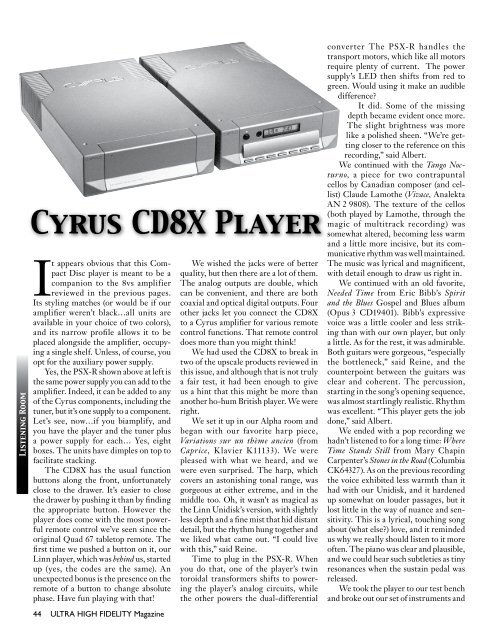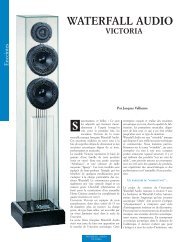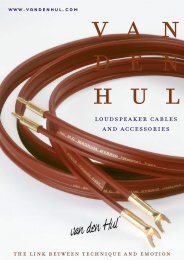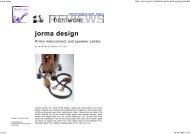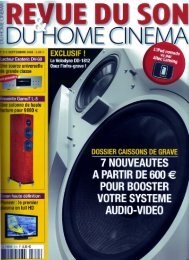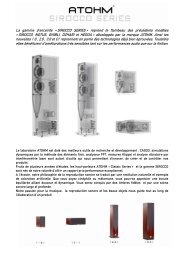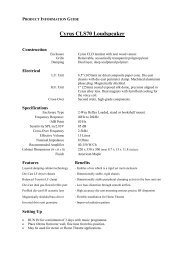Cyrus CD8X Player - Jefferson Hifi
Cyrus CD8X Player - Jefferson Hifi
Cyrus CD8X Player - Jefferson Hifi
Create successful ePaper yourself
Turn your PDF publications into a flip-book with our unique Google optimized e-Paper software.
Listening Feedback Room<br />
<strong>Cyrus</strong> <strong>CD8X</strong> <strong>Player</strong><br />
It appears obvious that this Compact<br />
Disc player is meant to be a<br />
companion to the 8vs amplifier<br />
reviewed in the previous pages.<br />
Its styling matches (or would be if our<br />
amplifier weren’t black…all units are<br />
available in your choice of two colors),<br />
and its narrow profile allows it to be<br />
placed alongside the amplifier, occupying<br />
a single shelf. Unless, of course, you<br />
opt for the auxiliary power supply.<br />
Yes, the PSX-R shown above at left is<br />
the same power supply you can add to the<br />
amplifier. Indeed, it can be added to any<br />
of the <strong>Cyrus</strong> components, including the<br />
tuner, but it’s one supply to a component.<br />
Let’s see, now…if you biamplify, and<br />
you have the player and the tuner plus<br />
a power supply for each… Yes, eight<br />
boxes. The units have dimples on top to<br />
facilitate stacking.<br />
The <strong>CD8X</strong> has the usual function<br />
buttons along the front, unfortunately<br />
close to the drawer. It’s easier to close<br />
the drawer by pushing it than by finding<br />
the appropriate button. However the<br />
player does come with the most powerful<br />
remote control we’ve seen since the<br />
original Quad 67 tabletop remote. The<br />
first time we pushed a button on it, our<br />
Linn player, which was behind us, started<br />
up (yes, the codes are the same). An<br />
unexpected bonus is the presence on the<br />
remote of a button to change absolute<br />
phase. Have fun playing with that!<br />
44 ULTRA HIGH FIDELITY Magazine<br />
We wished the jacks were of better<br />
quality, but then there are a lot of them.<br />
The analog outputs are double, which<br />
can be convenient, and there are both<br />
coaxial and optical digital outputs. Four<br />
other jacks let you connect the <strong>CD8X</strong><br />
to a <strong>Cyrus</strong> amplifier for various remote<br />
control functions. That remote control<br />
does more than you might think!<br />
We had used the <strong>CD8X</strong> to break in<br />
two of the upscale products reviewed in<br />
this issue, and although that is not truly<br />
a fair test, it had been enough to give<br />
us a hint that this might be more than<br />
another ho-hum British player. We were<br />
right.<br />
We set it up in our Alpha room and<br />
began with our favorite harp piece,<br />
Variations sur un thème ancien (from<br />
Caprice, Klavier K11133). We were<br />
pleased with what we heard, and we<br />
were even surprised. The harp, which<br />
covers an astonishing tonal range, was<br />
gorgeous at either extreme, and in the<br />
middle too. Oh, it wasn’t as magical as<br />
the Linn Unidisk’s version, with slightly<br />
less depth and a fine mist that hid distant<br />
detail, but the rhythm hung together and<br />
we liked what came out. “I could live<br />
with this,” said Reine.<br />
Time to plug in the PSX-R. When<br />
you do that, one of the player’s twin<br />
toroidal transformers shifts to powering<br />
the player’s analog circuits, while<br />
the other powers the dual-differential<br />
converter The PSX-R handles the<br />
transport motors, which like all motors<br />
require plenty of current. The power<br />
supply’s LED then shifts from red to<br />
green. Would using it make an audible<br />
difference?<br />
It did. Some of the missing<br />
depth became evident once more.<br />
The slight brightness was more<br />
like a polished sheen. “We’re getting<br />
closer to the reference on this<br />
recording,” said Albert.<br />
We continued with the Tango Nocturno,<br />
a piece for two contrapuntal<br />
cellos by Canadian composer (and cellist)<br />
Claude Lamothe (Vivace, Analekta<br />
AN 2 9808). The texture of the cellos<br />
(both played by Lamothe, through the<br />
magic of multitrack recording) was<br />
somewhat altered, becoming less warm<br />
and a little more incisive, but its communicative<br />
rhythm was well maintained.<br />
The music was lyrical and magnificent,<br />
with detail enough to draw us right in.<br />
We continued with an old favorite,<br />
Needed Time from Eric Bibb’s Spirit<br />
and the Blues Gospel and Blues album<br />
(Opus 3 CD19401). Bibb’s expressive<br />
voice was a little cooler and less striking<br />
than with our own player, but only<br />
a little. As for the rest, it was admirable.<br />
Both guitars were gorgeous, “especially<br />
the bottleneck,” said Reine, and the<br />
counterpoint between the guitars was<br />
clear and coherent. The percussion,<br />
starting in the song’s opening sequence,<br />
was almost startlingly realistic. Rhythm<br />
was excellent. “This player gets the job<br />
done,” said Albert.<br />
We ended with a pop recording we<br />
hadn’t listened to for a long time: Where<br />
Time Stands Still from Mary Chapin<br />
Carpenter’s Stones in the Road (Columbia<br />
CK64327). As on the previous recording<br />
the voice exhibited less warmth than it<br />
had with our Unidisk, and it hardened<br />
up somewhat on louder passages, but it<br />
lost little in the way of nuance and sensitivity.<br />
This is a lyrical, touching song<br />
about (what else?) love, and it reminded<br />
us why we really should listen to it more<br />
often. The piano was clear and plausible,<br />
and we could hear such subtleties as tiny<br />
resonances when the sustain pedal was<br />
released.<br />
We took the player to our test bench<br />
and broke out our set of instruments and
Listening Feedback Room<br />
test recordings. The 100 Hz square wave<br />
is shown above left. It exhibits quite a<br />
bit of overshoot on the risers, which<br />
is common, but it is quickly damped.<br />
The tilt of the top of the wave indicates<br />
that there is a mild rolloff of extreme<br />
highs (well…extreme for a CD player at<br />
least).<br />
At upper right is the low-level sine<br />
wave, 60 dB below maximum level. Its<br />
shape is quite reasonable, but we were<br />
surprised to note that it is contaminated<br />
by noise, a rarity today.<br />
The <strong>Cyrus</strong> did well on our Pierre<br />
Verany test disc, whose 1 kHz test tracks<br />
are sliced through by increasing large<br />
laser burns. Jitter was commendably low<br />
Summing it up…<br />
Brand/model: <strong>Cyrus</strong> <strong>CD8X</strong>/PSX-R<br />
Price: C$2799, $1050 for the PSX-R<br />
Dimensions: 21.3 x 34.8 x 7.5 cm<br />
Most liked: Coherent detail, beautifully<br />
natural on most material, even<br />
better with the PSX-R supply<br />
Least liked: Hardening of some<br />
higher-pitched sound<br />
Verdict: A player worth trading up to<br />
on the uncut track, increasing slightly<br />
with a narrow (0.05mm) cut, and even<br />
more with a 0.2mm cut. By the time<br />
we got to the track with the 2mm cut<br />
the player let through an occasional<br />
noise burst. With a 2.5mm cut, which<br />
is beyond Red Book spec, the <strong>Cyrus</strong><br />
suffered from uncorrected noise bursts,<br />
but it did not mute, nor did it mistrack.<br />
Our initial favorable impression<br />
of this player was confirmed by our<br />
listening session. By itself, it is a fine<br />
performer. Add the extra box, right<br />
away or later, and everything simply gets<br />
better. We liked it.<br />
CROSSTALK<br />
When we received this player I assumed<br />
it cost considerably less than it does, perhaps<br />
because the old <strong>Cyrus</strong> stuff was so cheap…15<br />
years ago. Finding out the 21 st Century price<br />
wasn’t a letdown, though, because by then I<br />
had heard it and I figured out the truth. Its<br />
performance is musically exciting, and it is<br />
perfectly in line with the price.<br />
Read the full review, and you’ll learn<br />
that, in a number of ways, it isn’t quite as<br />
refined as our Linn Unidisk player. Shocking,<br />
eh?<br />
If you’re looking for a top-grade source<br />
for your system, it’s important that you at<br />
least know about the <strong>Cyrus</strong>. And that’s true<br />
with or without that extra power kit.<br />
—Gerard Rejskind<br />
I sat staring between the speakers as we<br />
went through the first piece with this player,<br />
waiting to hear possible problems emerge as<br />
the music progressed. Nothing much. My<br />
eyes followed the image, and it appeared<br />
clear and solid. Nothing yet. And then it was<br />
over.<br />
It didn’t stumble one bit (!), it waited<br />
steadily for its next challenge, and the next<br />
one was with its hefty power supply.<br />
What had sounded very good became<br />
excellent. The sound stage deepened, and<br />
so did the bass. The brass glowed.<br />
But life is not perfect (and why should it<br />
be?), so I couldn’t help notice the analytical<br />
character it displayed, adding tremendous<br />
detail in strings and lyrics, but reducing the<br />
resonance and warmth I remembered.<br />
However it does so many things so well<br />
that I soon put that aside and enjoyed the<br />
music thoroughly.<br />
—Albert Simon<br />
I was worried when I learned that I was<br />
expected to evaluate a CD player with and<br />
without an add-on power supply. Sure, like<br />
I’d be able to tell the difference!<br />
I’m happy to report that I didn’t even<br />
hesitate. I emerged from this listening session<br />
enchanted, for several reasons. Even<br />
without the add-on, this player offers a wide<br />
array of advantages for the audiophile, and<br />
with the add-on block it only gets better. The<br />
music space becomes more comfortable in<br />
every sense. The stereo image is excellent.<br />
There is a sybaritic richness right across the<br />
spectrum. The lows get fatter, and drums<br />
resonate with exceptional impact.<br />
Indeed, such is the impact that at one<br />
point I had to restrain myself from getting up<br />
and dancing. You have to hear the tympani<br />
with this player. Explosive! Timbres are rich<br />
and often sumptuous, and the emotion of<br />
the artist is palpable. The piano is balanced<br />
and eloquent. Lyrics are easy to make out,<br />
and voices retain their warmth right into the<br />
upper frequencies.<br />
In really busy passages, the <strong>Cyrus</strong> player<br />
seems perfectly at ease, never distorting. It’s<br />
an excellent product.<br />
—Reine Lessard<br />
ULTRA HIGH FIDELITY Magazine 45


